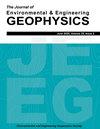Self-potential Data Interpretation for Two Co-axial Structures Utilizing the RMS Parameter
IF 0.7
4区 工程技术
Q4 ENGINEERING, GEOLOGICAL
引用次数: 4
Abstract
We have developed an algorithm to obtain the model parameters for two co-axial structures from self-potential data. The method uses the first numerical horizontal derivatives calculated from the observed self-potential anomaly employing filters of sequential window lengths (s-values) so as to gauge the model constraints for the shallow and deep structures. In addition, this algorithm uses a standard inversion method for solving a non-linear equation based on the lowest root-mean-square (RMS) error of the estimated model parameters. The body constraints are the depth, polarization angle and electric dipole moment of each structure. Our approach models the self-potential dataset as an aggregation of spheres, horizontal cylinders, and vertical cylinders. These simple bodies are used to approximate, without a priori expectations, the furthermost plausible position and/or area of intersection. In other words, the bodies are used to estimate the true values of the source parameters for the two-co-axial bodies at different s-values. Minimizing the RMS error has the advantage of optimizing all model factors. The proposed technique is tested using a numerical model with and without noise and on self-potential field data acquired at a site in Germany. In all cases, the assessed body parameters are reasonable approximations of the known values.利用RMS参数解释两种共轴结构的自电位
我们开发了一种从自电位数据中获得两种共轴结构模型参数的算法。该方法采用序列窗长(s值)滤波,从观测到的自势异常计算第一次数值水平导数,从而判断浅层和深部构造的模型约束条件。此外,该算法采用基于模型参数估计的最小均方根误差(RMS)的标准反演方法求解非线性方程。体约束是每个结构的深度、极化角和电偶极矩。我们的方法将自势数据集建模为球体、水平圆柱体和垂直圆柱体的集合。这些简单的物体被用来在没有先验期望的情况下,逼近最可能的交点位置和/或面积。换句话说,用这些体来估计两同轴体在不同s值下的源参数的真实值。最小化均方根误差具有优化所有模型因素的优点。利用德国某厂址的自电位场数据,对该方法进行了有噪声和无噪声的数值模型测试。在所有情况下,评估的物体参数都是已知值的合理近似值。
本文章由计算机程序翻译,如有差异,请以英文原文为准。
求助全文
约1分钟内获得全文
求助全文
来源期刊

Journal of Environmental and Engineering Geophysics
地学-地球化学与地球物理
CiteScore
2.70
自引率
0.00%
发文量
13
审稿时长
6 months
期刊介绍:
The JEEG (ISSN 1083-1363) is the peer-reviewed journal of the Environmental and Engineering Geophysical Society (EEGS). JEEG welcomes manuscripts on new developments in near-surface geophysics applied to environmental, engineering, and mining issues, as well as novel near-surface geophysics case histories and descriptions of new hardware aimed at the near-surface geophysics community.
 求助内容:
求助内容: 应助结果提醒方式:
应助结果提醒方式:


